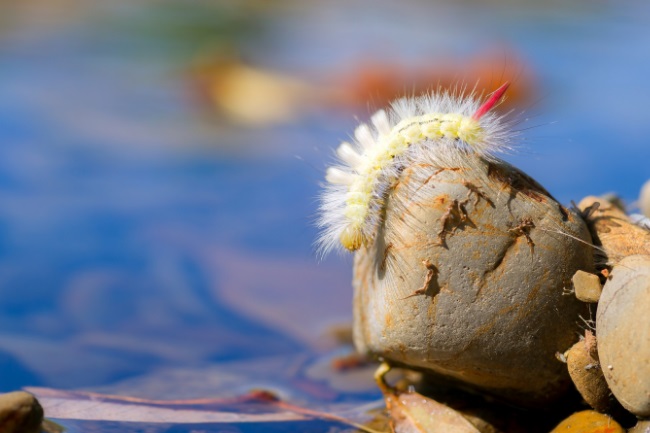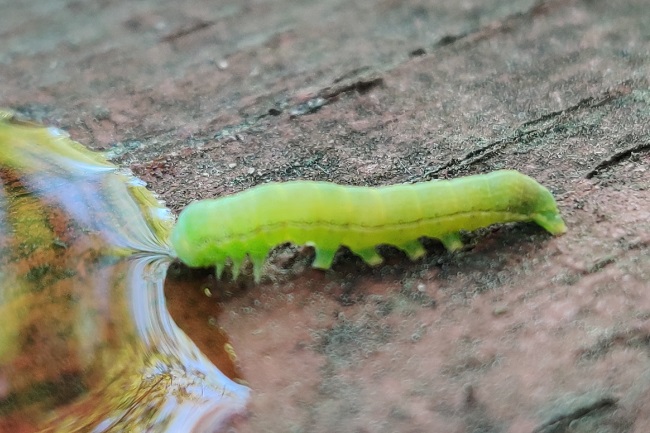Many caterpillars do not need to consume water by drinking it as a separate liquid from their food. Instead, they absorb it through their food, which for most species is plant matter. Some caterpillars with drier diets so drink, mostly making use of raindrops and dew.
Contents
Do insects drink?

Unlike mammals and birds, which we often see taking a slip at the edge of a lake or guzzling in the birdbath, we don’t tend to notice when insects take a drink. Yet, these tiny creatures get just as thirsty as the rest of us. How they get their water depends on what they eat. Many insects that live on a diet of vegetation don’t need to go out of their way to get moisture. Plant matter can have such a high water content that this meets the insect’s need entirely. Fruits and vegetables, in particular, provide a great deal of water for their pests.
Some plant eaters find they end up with so much liquid from their dinner that they need to get rid of it. Aphids and cicadas produce a byproduct known as honeydew. This is a sweet liquid which they exude to rid themselves of excess water and sugars. Whole ecosystems have evolved around this substance, with many other insects, and even mammals, feeding off this waste product.
| Water Source | Description |
|---|---|
| Plant Leaves | Caterpillars obtain water by consuming plant leaves, which have a high water content. |
| Dew | Caterpillars may drink water droplets present on leaves in the early morning, which is known as dew. |
| Rainwater | Caterpillars may collect water from rain showers by positioning themselves on leaves or other surfaces where water accumulates. |
| Moisture in Host Plants | Some host plants retain moisture on their surfaces, which caterpillars can access to meet their water needs. |
Not all vegan insects get enough moisture from their food to not need to drink anything. Alternative sources of water can include puddles and raindrops. A common source of water is dew, which coats vegetation when the air temperature changes after dawn. Some insects living in arid environments have evolved to use their bodies to capture this rare and essential resource. The desert toktokkie beetle has unique grooves and ridges designed to allow water to condense and be funnelled into the beetle’s mouth.
For those insects that eat meat, their diet isn’t as juicy as their vegan companions. Some, such as blood-sucking insects like ticks and mosquitos, get their thirst quenched by their vampire ways. But for those eating other insects or even amphibians or small mammals, they do need a good glug of water to keep them going.
Also read: Is a Caterpillar an Insect? (Explained)
Water, water, everywhere

Like other insects, whether a caterpillar needs to quench its thirst is largely down to its diet. The majority of caterpillars are vegan, eating only plant matter. Most focus on the leafy parts of the plants, though some will eat flowers or woody matter. Within this plant matter, there is a large amount of moisture, which the caterpillars can absorb. Some caterpillars produce honeydew, with these waste products often being utilised as a bribe for ant species to protect and care for the caterpillars.
Not all caterpillars eat vegetation, though, with a few having carnivorous lifestyles. Those caterpillars that prefer flesh will need a nice pint to wash down that steak. Whilst many insects may be able to fly to the nearest pond or have the time to go searching for water, caterpillars are in a bit of a rush. Busy eating as much as they can in order to get as big as possible, as quickly as possible, they will take advantage of whatever is close at hand, such as raindrops and dew.
Also read: What do Caterpillars Eat? (Vegan vs. Carnivore Caterpillars)
Drying out
Like all insects, caterpillars have a desiccation issue. This simply means that they are at risk of drying out. Because of this, they are very careful to conserve water. This means that they don’t produce urine, instead of excreting a solid waste, which is a mix of faeces and uric acid, known as frass. Additionally, their exoskeleton helps to avoid excessive water loss and protect them from becoming waterlogged.

In tropical regions, a caterpillar has little to fear when it comes to getting enough water, regular rains refreshing their supply. However, in arid areas, water can be a real constraint to these insects. Some species have adapted to come out to feed only during cooler times, such as during the night, or to bury themselves into the soil to take advantage of damper conditions. The emergence of a caterpillar from its egg can also be delayed until conditions are right, with hatching only occurring after rain or when the temperatures are seasonally lower. Such adaptations are vital in terms of coping with a lack of available water.
Also read: What Does Caterpillar Poop Look Like? (Insect Frass)
Even caterpillars get thirsty

So the truth is that even tiny caterpillars need a bit of water to survive. Whether they get this in their food or sip it separately, they can’t get by on food alone.
They manage their water losses as best they can, though many species are well adapted to up a 60% loss. When they do let out some water, they often use it to manipulate other insects into doing their bidding in the form of honeydew bribes. Yet, for many species, too much water is just as bad as too little, leading to waterlogging or, even worse, drowning. It’s a precarious balance for our little insects, between life and death.

